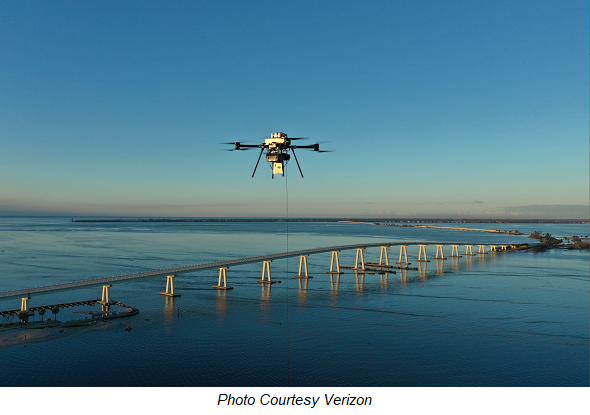Verizon Frontline Response is providing drones to help first responders in Florida with their rescue and recovery efforts. Tethered drones have been sent aloft to provide 5-7 mile wireless coverage areas, like Sanibel Island, which was separated from the mainland when the bridge collapsed during Hurricane Ian. The drone-supplied wireless coverage was requested by the local law enforcement and emergency management agencies to provide access to intelligence back at their forward command centers.
“It’s very difficult to get our traditional mobile assets into some of those areas, because of flooding and destruction, so we’re able to put a drone up in the air to create a coverage area where there’s a lot of search and rescue missions happening,” said Cory Davis, National Director for Verizon Frontline’s Response Team and Public Safety Operations. “This allows them to streamline their mission critical communications on situational awareness, while they try to find folks that are still missing.”
Drones are just one of the telecom assets being deployed in the wake of the most destructive hurricane to hit the Southwestern coast of Florida in decades. Verizon’s engineers are responding by deploying additional 5G technology in the Fort Myers area – Lee and Charlotte counties — to increase capacity for first responders, public safety officials and residents. “We literally have more than 100 assets in the theater throughout the state of Florida,” Davis said, “including portable generators, cells on wheels, satellite cells on light trucks.”
The Verizon Frontline Crisis Response team is available 24/7 to aid first responders with their communication needs, whether it is mobile assets, phones, WiFi hotspots or Cradlepoint routers. “We have a team that is delivering all these communication solutions to these first responder agencies on demand as well, at no costs. So this is all a value and it’s all part of our Verizon Frontline offering,” Davis said.
Verizon engineers have been on the ground since before the storm readying teams to provide wireless connectivity in the state in the wake of the storm, coordinating with emergency management teams. Verizon engineers partner directly with the state and local Emergency Operations Centers on restoration priorities and community needs.
“Our Gulf Coast infrastructure is built to withstand a Category Five hurricane or sustained winds of more than 150 MPH,” Davis said. “Nearly 90 percent of all macro sites have generator backup and 100 percent of the microsites also have battery backup. Ongoing refueling operations are underway to ensure permanent and portable generators remain in service until commercial power can be restored.”
By J. Sharpe Smith, Inside Towers Technology Editor





Reader Interactions